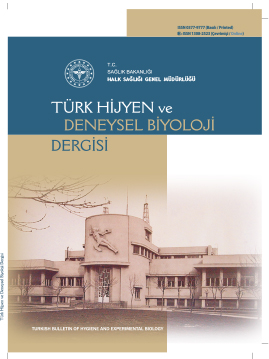
Bu eser Creative Commons Alıntı-GayriTicari-Türetilemez 4.0 Uluslararası Lisansı ile lisanslanmıştır.













Volume: 73 Issue: 1 - 2016
| FULL JOURNAL | |
| 1. | TBHEB 2016-1 Vol 73 Full Printed Journal Murat DUMAN doi: 10.5505/TurkHijyen.2016.02438 Pages 0 - 98 Abstract | |
| RESEARCH ARTICLE | |
| 2. | Clonal Analysis of Vancomycin-Resistant Enterocci Strains by rep-PCR Method Seyit Ahmet Bayık, İpek Mumcuoğlu, Şenol Kurşun, Neriman Aksu doi: 10.5505/TurkHijyen.2016.94809 Pages 1 - 8 INTRODUCTION: Vancomycin-resistant enterococci (VRE) has become an important nosocomial pathogens because of its rapid spread, significant mortality rates, limited options for therapy, and the possible transfer of vancomycin resistance to more-virulent pathogens. Active surveillance should be done to prevent VRE infections in hospitals. Molecular typing is most convinient method to show route of transmission during a surveillance. However, adequate, easy-to-perform, and reproducible typing methods are lacking. The ease of use and more rapid turnaround time offers a rapid screening method to detect outbreaks of VRE and more rapidly implement control measures. In this study it was aimed to performed clonal analysis of VRE strains with rep-PCR in a one month period. METHODS: During one month period, a total of 48 VRE strains obtained from four clinical specimens, 18 rectal swab samples and 26 environmental cultures. Identification and antibiotic susceptibility tests of isolates was evaluated by automated Vitek-2 (bioMérieux, France) system. Confirmation of vancomycin resistance was done by agar dilution method according to CLSI recommendations. Clonal analysis was performed by rep-PCR (DiversiLab, France) method. RESULTS: All 48 strains including the study identified as E. faecium Four clones was evaluated by rep-PCR analysis and named as A, B, C, D which including 35, 3, 2, 2 strains respectively while six strains could not classified. DISCUSSION AND CONCLUSION: The surveillance of VRE in risky clinics has been performed to prevent hospital infection since the first isolation of VRE in our hospital in 2004. It is important to show source of contamination and route of transmission in a short time for more effective surveillance. In this study clonal analysis of VRE strains was performed by rep-PCR. As a result rep-PCR which is a rapid and easy performed method, can easily be applied for epidemiological purposes and aid to infection control measures. |
| 3. | Antibiotic Resistance and Metallo-Beta-Lactamase Positivity in Carbapenem-Resistant Non-Fermentative Gram-Negative Bacilli Mustafa Güzel, Yasemin Genç, Altan Aksoy, Penka Moncheva, Petya Hristova doi: 10.5505/TurkHijyen.2016.55706 Pages 9 - 14 INTRODUCTION: Antibiotic resistance in Gram-negative bacteria is an increasing problem worldwide and a challenging issue for the physicians in both nosocomial and community-acquired infections. Infections caused by metallo-beta-lactamase (MBL)-producing bacteria are particularly threatening as the resistance genes of these bacteria may render an entire antibiotic class ineffective. Moreover, the rates of multidrug-resistant strains are higher among MBL-producing bacteria. Multidrug resistance has been gradually increasing among non-fermentative Gram-negative bacilli (NFGNB). The present study aimed to investigate resistance rates of carbapenem-resistant NFGNB isolated from patients’ specimens to other antibiotics and to evaluate MBL production by E-test method. METHODS: Carbapenem-resistant NFGNB, which were isolated from the inpatients’ specimens sent from January 2014 through March 2015 to Ankara Numune Training and Research Hospital Medical Microbiology Laboratory, were included. Imipenem- and/or meropenem-resistant strains were considered as carbapenem-resistant. Meropenem/meropenem+EDTA E-test strips were used for phenotypic MBL detection. RESULTS: The study included 110 carbapenem-resistant NFGNB strains. Of these strains, 44.5% were Acinetobacter baumannii and 36.4% were Pseudomonas aeruginosa. The NFGNB strains were mostly isolated from tracheal aspirate (37.9%), followed by blood (22.3%), wound (17.5%), and urine (13.6%) specimens. When all carbapenem-resistant NFGNB strains were considered, the highest rate of resistance was ampicillin-sulbactam (95.5%), followed by ciprofloxacin (87.8%), and cefepime (83.3%). Of 110 strains, only 1 (0.9%) was determined to be MBL positive. This was an Acinetobacter baumannii isolated from urine sample. DISCUSSION AND CONCLUSION: Detection of enzyme-producing strains by appropriate antibiogram and routine MBL screening of clinical isolates, surveillance, and reasonable antibiotic use are essential in the control of resistant NFGNB infections, the rate of which is gradually increasing and the treatment of which is difficult and costly. |
| 4. | Evaluation of Risk factors of Candida albicans and non-albicans Candida Candidemia in a Tertiary-Care Hospital for Three Years. Hikmet Eda Alışkan, Emine Duygu Bozkırlı, Şule Çolakoğlu, Müge Demirbilek doi: 10.5505/TurkHijyen.2016.49369 Pages 15 - 24 INTRODUCTION: Objective: Bloodstream infections by Candida species are one of the most important cause that increase morbidity and mortality in hospitalized patients. Candida species are the most common isolated from bloodstream infections that caused by fungi. In addition to C.albicans, there was a gradually increase in the prevalence of candidemia caused by non-albicans Candida (NAC) species. In our study, we compared the risk factors for candidemia and determined the risk factors that cause of CA and NAC species in adult and pediatrics patients in a Tertiary-Care Hospital for three years. METHODS: Methods: Blood culture were collected from patients suspected candidemia were inoculated into BACTEC Aerobik/F bottles. The blood cultures were inoculated an automated system BACTEC 9240 (Becton Dickinson, Maryland, USA). The blood culture that signalized an positive alarm were subcultured on the %5 blood and chocolate agars. Germ tube test was performed on isolated yeast colonies. Germ tube test negative colonies were identified according to biochemicals tests using API 20C AUX (BioMérieux, France). Germ tube test positive isolates were identified as non-albicans Candida. RESULTS: Results: A total of 163 blood cultures of the patients isolated Candida species, 0-17 age range of 100 (61.3%), >17 years 63 (38.4%) and they were 86 males (%52.7) and 77 females (%47.2). Out of 163 cases in total, 150 episodes were nosocomial infections and 13 episodes were community- aqcuired infections. CA was recovered from 79 (48.5%) of the patients, whereas NAC were isolated from 84 (51.5 %). Examining the distribution of Candida species, CA 79 (48.5%); C. parapsilosis 54 (32.9 %), C. tropicalis 10 (6.1%), C. famata 10 (6.1%), C. glabrata 5 (3.0%) and others (C. pelliculosa, C. crusei and C. norvogensis) 5 (3.0%) to a total of 84 types of NAC were found to be. DISCUSSION AND CONCLUSION: Conclusion: Recent TPN, presence of central venous catheter, underlying diseseases (malignancy and burns) and previous antibiotics treatment were determined as the risk factors for candidemia. Additionaly previous antifungal treatment (p<0,05 ) and prior burn surgery, for example: early surgical excision of burned tissue, with debridement of necrotic tissue and grafting of skin, were associated with an increased risk of NAC species candidemia. |
| 5. | Acinetobacter species isolated from various clinical specimens between 2006-2011 years and their susceptibilities against antibiotics Cafer Eroğlu, Nevzat Ünal, Adil Karadağ, Hava Yılmaz, İbrahim Çağatay Acuner, Murat Günaydın doi: 10.5505/TurkHijyen.2016.68915 Pages 25 - 32 INTRODUCTION: OBJECTIVE: The aim of this study is to investigate the distribution and antibiotic susceptibility of Acinetobacter species isolated in our hospital in the last six years. METHODS: Acinetobacter species isolated from various clinical samples sent to Ondokuz Mayıs University, Medical Faculty Hospital Central Laboratory, Bacteriology Sub-Discipline Laboratory between January 2006 and June 2011 were included. Conventional methods and Vitek 2 Compact (bioMérieux-SE France) automated systems were used for the identification and antibiotic susceptibility of the isolates. RESULTS: During the study period, a total of 3212 Acinetobacter species were isolated. Species distribution of Acinetobacter isolates and their ratios are as follows: Acinetobacter baumannii- Acinetobacter calcoaceticus complex (n=3006; % 93.6%), Acinetobacter lwoffii (n=83; 2.6%), Acinetobacter junii (n=27;0.8%), Acinetobacter haemolyticus (n=19; 0.6%) and Acinetobacter spp. (n=77; 2.4%). Acinetobacter isolates were commonly isolated from tracheal aspirate samples (n=747; 23.2%) and samples sent from intensive care units (n=705; 21.9%). Ceftazidime resistance increased from 70.2% to 82.7%; cefepime from 26.4% to 79.7%; imipenem from 27.2% to 77.2%; meropenem from 4.5% to 77% and ciprofloxacin from 40.4% to 78.9% in the last six years. In the first six months of 2011, the resistance ratios to tigecycline and colistin were 5.9% and 0.2% respectively. No significant changes were observed in ampicillin-sulbactam rasistance ratios. DISCUSSION AND CONCLUSION: CONCLUSION: Considering all findings, high-level resistance to cefepime, piperacillin-tazobactam, ceftazidime, ceftriaxone, meropenem, imipenem, ciprofloxacin and levofloxacin were observed as of first half of 2011. Colistin resistance in Acinetobacter species was minimal. Significantly reduced resistance to gentamycin, an antibiotic of aminoglycoside group, was attributed to its less frequent use in recent years. As shown in our study, antibiotic resistance is gradually increasing in Acinetobacter species. In the future, new antibiotics will be required for the treatment of infections caused by Acinetobacter species. However, new treatment options are limited. In conclusion, we are in the opinion that spread of pan-resistant strains which may pose serious problems in the near future can be decelerated by promoting the rational use of antibiotics. |
| 6. | Evaluation of anti-Toxoplasma IgM-IgG Seropositivity among Women in Reproductive Period, Who Amitted to Suleyman Demirel University Hospital Ayşe Aynali, Buket Cicioğlu Arıdoğan, Esra Nur Tola, Süleyman Önal, Emel Sesli Çetin doi: 10.5505/TurkHijyen.2016.35683 Pages 33 - 38 INTRODUCTION: Toxoplasma gondii (T. gondii) causes generally an asymptomatic infection. If it develops during pregnancy, it can cause some fetal disorders. In this study, it was aimed to determine the seroprevalence of toxoplasmosis in women in the ages of 15-49, who admitted to our hospital in Isparta. METHODS: Seropositivity of anti-T. gondii IgG and IgM were determined among 15-49 years old women admitted to Medical Microbiology Laboratory in our hospital, between January 2013 and December 2013. Anti-Toxoplasma IgM and anti-Toxoplasma IgG tests in the serum of patients were measured with chemiluminescence method (Vıtros, Johnson&Johnson, ABD). Toxoplasma avidity tests in the serum of patients were measured with Enzyme-Linked Fluorescent Assay (ELFA) method (VIDAS, bio-Merieux, Fransa). RESULTS: The mean age of women was 29.78±5.95. In this study anti-Toxoplasma IgM positivity rate of % 5.2 (45/862) and anti-Toxoplasma IgG seropositivity rate of % 24.4 (194/794) were determined. High, low and borderline avidity value rate of anti-Toxoplasma IgG avidity test were found as %84.6 (55/65), %12.3 (8/65), %3.1 (2/65) respectively. DISCUSSION AND CONCLUSION: The sensitive group of T. gondii infection has been observed that are not small in women in the ages of 15-49, who admitted to our hospital. |
| 7. | Evaluation of knowledge and attitudes of a university hospital auxiliary staff about hospital infections Selma İnfal, Tahir Kemal Şahin doi: 10.5505/TurkHijyen.2016.93064 Pages 39 - 48 INTRODUCTION: This study was carried out on the auxiliary staff working in a university hospital, to assess their knowledge and attitudes about nosocomial infections (NI). METHODS: A questionnaire was used to collect the data, including questions related to the subject. The questionnaire consists of two parts. The first part includes some questions aiming to determine the socio-demographic characteristics and working status of the participants. In the second part, there is a list of questions intended to detect the knowledge and attitudes about NI. The knowledge related questions were scored and the assessment was made out of 100 points, whereas the attitude related questions were assessed in percentage (%) terms. RESULTS: 32,1% of auxiliary staff stated that they wash their hands before each treatment, whereas 14,1% of them wash hands after each treatment. Moreover, 83,1% of staff use soapy water for washing their hands. The percentage of the auxiliary staff who could make the color separation of medical, household and recyclable waste bags was found to be 6%. In order to protect themselves from NI while they are carrying out their duties, 38,1% of the auxiliary staff said that they wear gloves, 26,3% of them said that they use masks and 21,2% of them said that they wash their hands. The mean score of the auxiliary staff on knowledge related questions about NI was 40.9±15.7 points. DISCUSSION AND CONCLUSION: It was concluded that the auxiliary staff are not aware of their own role in preventing infection and they are also not aware of the importance of NI. Organizing in-service training programs for auxiliary staff to develop an understanding of the importance of NI and to make the auxiliary staff realize their role in preventing these infections, ensuring continuity of these training programs and keeping them up-to-date, and finally, emphasizing the knowledge and subjects that indicate insufficient transference of knowledge to behavior can play a significant role in the prevention and control of NI. |
| CASE REPORT | |
| 8. | Case report: A case of otitis externa due to Vibrio alginolyticus Irmak Baran, Aydın Acar, Yasemin Genç, Neriman Aksu doi: 10.5505/TurkHijyen.2016.90592 Pages 49 - 54 Vibrio alginolyticus is a gram negative bacillus which loves to live in warm and salty seawater and may rarely be infectious agent in humans. In this case report we present a 15-year-old female patient in whose ear culture pure and dense growth of V. alginolyticus was observed. It was learned that before the onset of symptoms the patient spent her holiday near seaside and swam regularly. Therefore, it was thought that the contamination was through seawater. V. alginolyticus was susceptible to all antibiotics tested. Patient has returned to health with amoxicillin-clavulanic acid and ciprofloxacin therapy. Our country is surrounded by seas on three sides, but report of otitis externa by V. alginolyticus is very rare, so this case was presented to draw attention to this issue. |
| REVIEW | |
| 9. | Vaccine Epidemiology: Epidemiologic Measures of the Effects of a Vaccine and Vaccination Can Hüseyin Hekimoğlu doi: 10.5505/TurkHijyen.2016.90377 Pages 55 - 70 Vaccination is one of the most successful and cost-effective interventions in prevention of diseases. The effect of a vaccine is shown by the percent reduction in the incidence of the outcome of interest among vaccinated people compared with those unvaccinated. When the effect of a vaccine is calculated under ideal conditions with randomized controlled studies, vaccine efficacy is obtained; and when calculated on the sub-optimal field conditions with observational studies, vaccine effectiveness is obtained. After a licensed vaccine which its efficacy was identified is introduced into a population, vaccination effectiveness should be monitored as a part of disease surveillance. It should be well known that vaccine efficacy and vaccine effectiveness are not the same concepts. In addition to the vaccine effect on the individual level, the indiret effect, total effect and overall effect of the vaccination programs on the population level should be evaluated. The public health impact of vaccination can also be defined by measurements such as "population prevented fraction, population preventable fraciton". Conditional parameters like transmission probability and secondary attack rate can provide vaccine effect estimates with less bias. As well as the biological protective effect of a vaccine, exposure or behavior effect, contact rate effect and vaccine effect on infectiousness and the combined effects of a vaccine are important in order to understand the dynamics of transmission of an infectious agent in a population. One of the most important determinants of vaccine effect in a population is the vaccine coverage. Rapid and continuous monitoring of the vaccine effectiveness based on the vaccine coverage guides the planning public health interventions. To determine the targeted herd immunity threshold for prevention of outbreaks in a population, the basic reproduction number, vaccine coverage and vaccine effectiveness should be known. Number needed to vaccinate is a measure more widely used in recent years in the planning of public health actions and evaluating vaccination programme. Determination and interpretation of benefits of vaccination on the individual and population level by using these epidemiological measures is important for public health policies. |
| 10. | The Nature Of Enterococcal Biofilm Structure, A Risk Factor For Human And Animal Health Maryam Dıanı, Mohammad Nima Arıafar, Nefise Akçelik doi: 10.5505/TurkHijyen.2016.48802 Pages 71 - 80 Enterococci, generally considered as normal bowel commensals, are also recognized as opportunistic pathogens and rank among the top 3 causes of bowine mastitis beside nosocomial bloodstream, surgical site, and urinary tract infections. Enterococcus faecalis is the most common enterococci species, and it is responsible for 80–90% of human and animal enterococcal infections. Enterococcus faecium accounts for the remainder of infections caused by enterococci spp. Biofilms are highly organized structures formed by one or more bacteria species bound together by a carbonhydrate matrix that contain water channels to deliver nutrients and removes wastes. Biofilm structure works as a shield with its eksopolysaccharide and protein film layer and often harder to kill them than their planktonic counterparts. Biofilm bacteria are up to 1000 times more resistant to phagocytosis, antibodies and antibiotics. Enterococci can infect humans and domestic animals because of their many virulence factors associated with biofilm formation including gelatinase, aggregation substance, capsule formation, enterococcal surface protein. Furthermore, since they are also resistant against antibiotics such as vancomycin that used at treatment, it is really difficult to eradicate. Many strains of enterococci are resistant to one or more antibiotics and biofilms are thought to contribute to this resistance. In all over the world, to achieve better results at eradication of this organism; structure and molecular mechanism of biofilm need to be understood for determination of new drug dosages and new treatment strategies to eradicate biofilm. |
| 11. | Polycystic ovary syndrome and molecular approaches Alp Aydos, Yasemin Öztemur, Bala Gür Dedeoğlu doi: 10.5505/TurkHijyen.2015.09327 Pages 81 - 88 Polycystic ovary syndrome (PCOS) is an endocrine disorder, which affects women at reproductive age. Syndrome is characterized by hyperandrogenism, polycystic ovarian morphology and ovulatory dysfunction. PCOS is associated with reproductive and metabolic abnormalities including infertility, insulin resistance and type 2 diabetes. Prevalence of PCOS changes by diagnostic criteria for PCOS. According to ESHRE/ASRM (European Society of Human Reproduction and Embryology / American Society for Reproductive Medicine) criteria PCOS is diagnosed at nearly 15%-20% of women. Adult women, who have type 1-2 diabetes, are under high risk of PCOS. 50%-70% of PCOS patients are affected by insulin resistance. Diseases like hypertension, dyslipidemia, glucose intolerance, diabetes are highly associated with insulin resistance and PCOS. In addition, hirsutism and menstrual irregularities could occur with PCOS. Studies show that there is a relation between PCOS and cardiovascular diseases and cancer as well. Studies identified that mental disorders like depression, anxiety, bipolar disorder and binge eating disorder (BED) are frequently seen at PCOS patients. The treatment strategies applied to PCOS patients vary according to the hormonal status and profile of the patient. Clomiphene citrate-metformin therapy, fertility treatments, laparoscopic ovarian surgery or gonadotrophin hormone therapy are the most frequent therapies used for treatment of PCOS. PCOS is a complex disorder, which includes metabolic, endocrinologic, psychiatric and cardiovascular effects. These effects could be lifetime long and could decrease quality of life. Thus identifying more effective diagnosis and treatment approaches is important for protecting patients from diabetes, cancer and cardiovascular diseases. The etiology of PCOS is still unclear however the investigation of familial distinction of PCOS is stable with a genetic basis for this disorder. It was shown in the literature that the differential expression of some genes may be the cause of ovarian dysfunction by affecting the pathways responsible for ovarian development like Wnt signaling pathway. Revealing the molecular mechanisms of PCOS and discovering genes, which are associated with PCOS are important for developing new diagnosis and treatment methods. |
| 12. | An re-emerging arboviral infectious agent: Zika virus Yavuz Uyar doi: 10.5505/TurkHijyen.2016.80269 Pages 89 - 98 Zika virus (ZIKV), is an arbovirus (arthropod borne virus) belonging to the Flavivirus genus that was first isolated from a Rhesus monkey in 1947 in Uganda. The transmission is mostly vectorial by mosquitoes of the Culicidae family and of the Aedes genus (mostly Aedes aegypti). Non-human primates and possibly rodents play a role as reservoir. The symptoms (fever, maculopapular rush, arthralgia and conjunctivitis) appear after an incubation period after the mosquito bite and usually last three to 12 days. Asymptomatic cases are frequent. In recent years, virological studies have allowed identifying the virus in Africa, Asia, and Oceania, in the Pacific. Beginning at the end of 2013, a large outbreak affected the West Pacific islands. In 2015, Brazilian local health authorities also observed an increase in babies born with microcephaly at the same time of an outbreak of ZIKV. Preliminary diagnosis is based on the clinical features of patient, places and travel dates, and activities. Laboratory diagnosis of ZIKV is generally performed by testing serum or plasma to detect virus, viral nucleic acid, or virus-specific immunoglobulin M and neutralizing antibodies. Unfortunately, there is no specific treatment or vaccine for ZIKV infection. The treatment is symptomatic. Prevention against the infection relies on individual protection against mosquito bites and eradication of mosquitoes in outbreak areas. |


